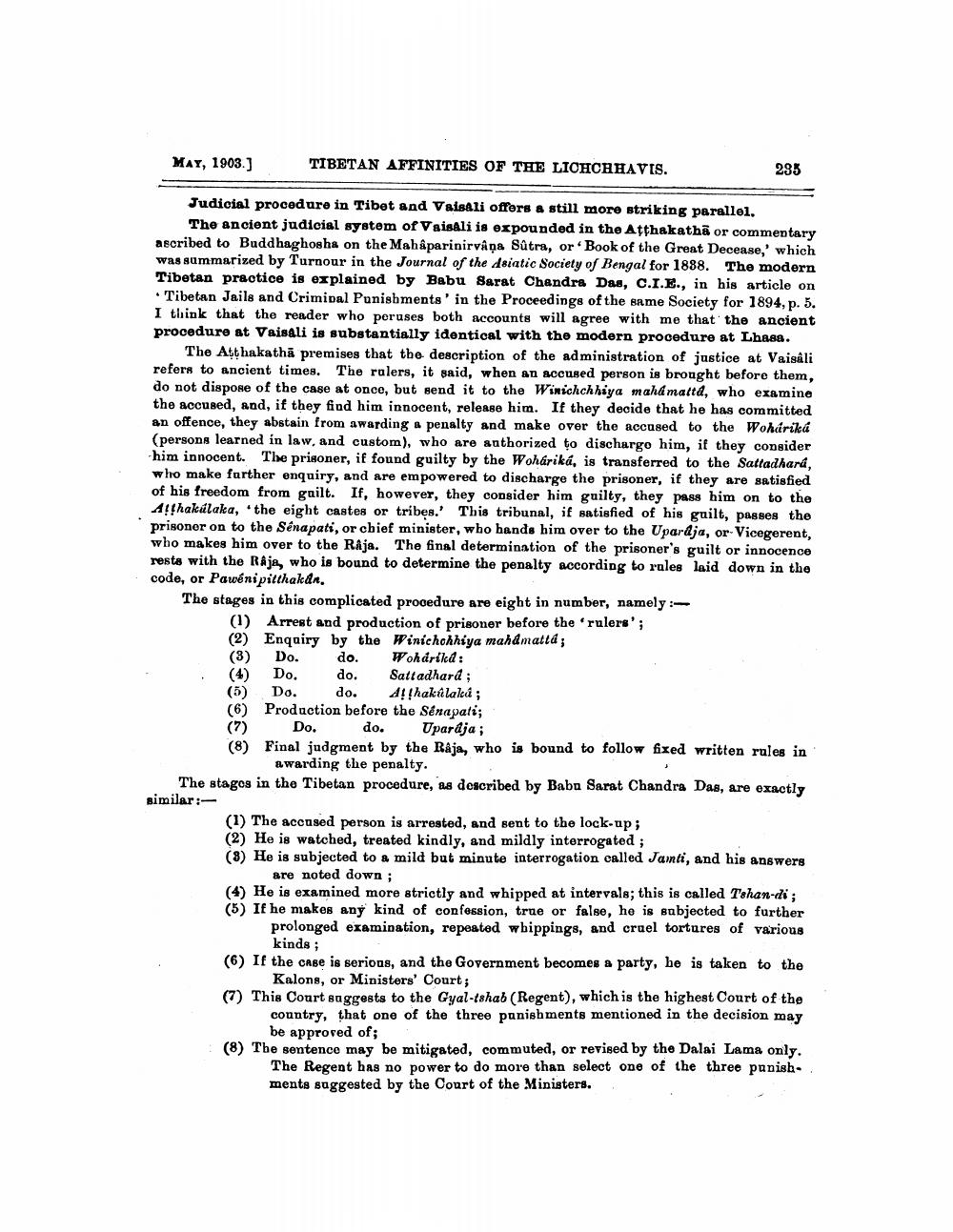________________
MAY, 1903.)
TIBETAN AFFINITIES OF THE LICHCHHAVIS.
235
Judicial procedure in Tibet and Vaisali offors & still more striking parallel,
The ancient judicial system of Vaisali is expounded in the Atthakathā or commentary ascribed to Buddhaghosha on the Mahaparinirvana Sutra, or Book of the Great Decease,' which was summarized by Turnour in the Journal of the Asiatic Society of Bengal for 1888. The modern Tibetan practice is explained by Babu Sarat Chandra Das, C.I.E., in his article on • Tibetan Jails and Criminal Punishments' in the Proceedings of the same Society for 1894, p. 5. I think that the reader who peruses both accounts will agree with me that the ancient procedure at Vaisali is substantially identical with the modern procedure at Lhasa.
The Asthakathā premises that the description of the administration of justice at Vaisali refers to ancient times. The rulers, it said, when an accused person is brought before them, do not dispone of the case at once, but send it to the Wirichchhiya maha mattd, who examine the accused, and, if they find him innocent, release him. If they decide that he has committed an offence, they abstain from awarding a penalty and make over the accused to the Woháriká (persons learned in law, and custom), who are authorized to dischargo him, if they consider him innocent. The prisoner, if found guilty by the Woháriká, is transferred to the Sattadhará, who make further enquiry, and are empowered to discharge the prisoner, if they are satisfied of his freedom from gailt. If, however, they consider him guilty, they pass him on to the Althakúlaka, the eight castes or tribes.' This tribunal, if satisfied of his guilt, passes the prisoner on to the Sénapati, or chief minister, who hands him over to the Upardja, or Vicegerent, who makes him over to the Raja. The final determination of the prisoner's guilt or innocence rests with the Râjs, who is bound to determine the penalty according to rules laid down in the code, or Pawéni pitthakar. The stages in this complicated procedure are eight in number, namely:
(1) Arrest and production of prisoner before the rulers'; (2) Enquiry by the Winichohhiya mahdmatta; (3) Do. do. Wohárikd: (4) Do. do. Sattadhard ; (5) Do. do. 4!!hakalakú; (6) Production before the Sénapati;
Do. do. Upardja; (8) Final judgment by the Rája, who is bound to follow fixed written rules in
awarding the penalty. The stagos in the Tibetan procedure, as described by Babu Sarat Chandra Das, are exactly similar:
(1) The accused person is arrested, and sent to the lock-up; (2) He is watched, treated kindly, and mildly interrogated; (8) He is subjected to a mild but minute interrogation called Jamti, and his answers
are noted down ; (4) He is examined more strictly and whipped at intervale; this is called Tohan-di; (5) If he makes any kind of confession, true or false, he is subjected to further
prolonged examination, repeated wbippings, and cruel tortures of various
kinds; (6) If the case is serious, and the Government becomes a party, he is taken to the
Kalons, or Ministers' Court; (7) This Court suggests to the Gyal-tshab (Regent), which is the highest Court of the
country, that one of the three panishments mentioned in the decision may
be approved of; (8) The sentence may be mitigated, commuted, or revised by the Dalai Lama only.
The Regent has no power to do more than select one of the three panishments suggested by the Court of the Ministers.




